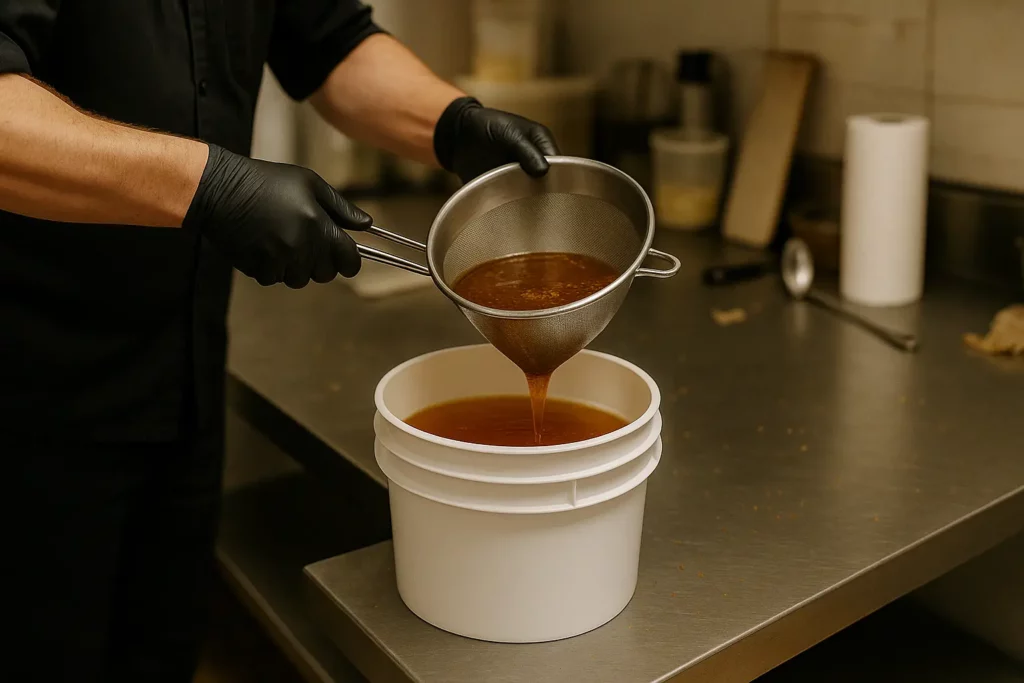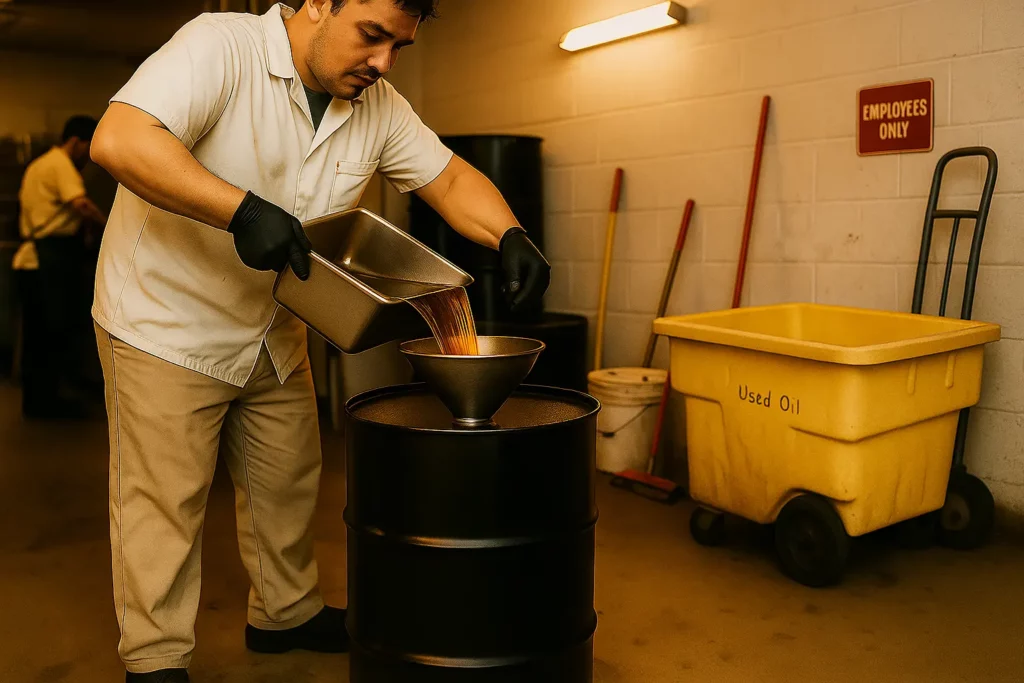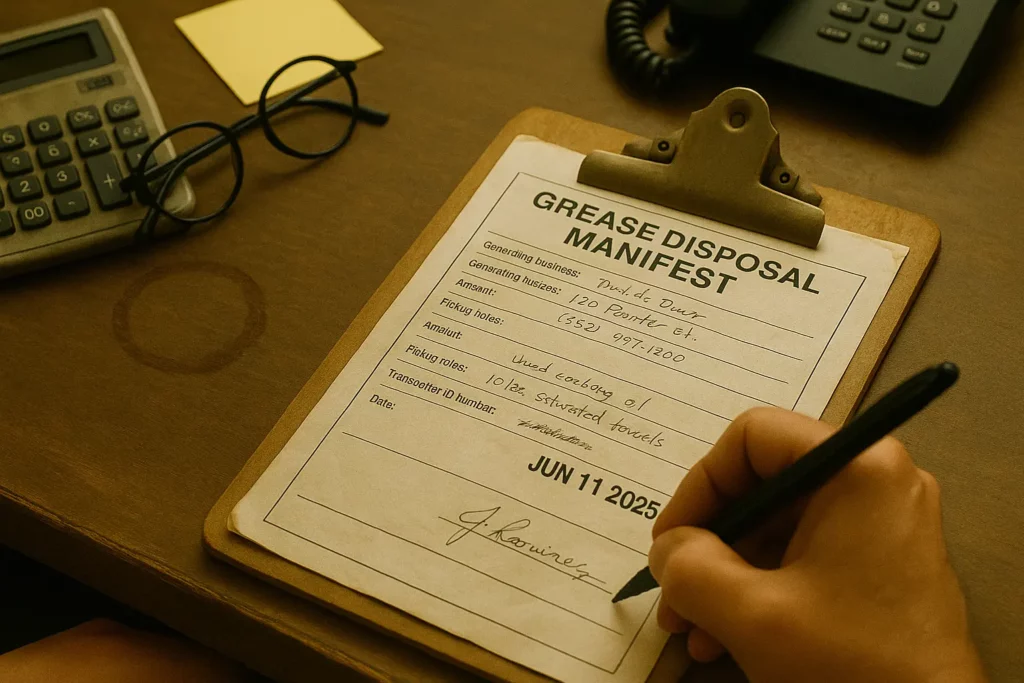Last Updated: June 2025
Quick answer: The safest, most profitable way to dispose of large volumes of restaurant cooking oil is to store it in a sealed yellow grease tank and schedule a licensed hauler who pays today’s market rate (≈ $0.33–0.42/lb USDA, Jun 2025)—never pour it into drains.
Table of Contents
Why Used Cooking Oil Is Liquid Gold in 2025
The global used cooking oil market reached $6.90 billion in 2024 and is projected to hit $12.85 billion by 2032, according to Fortune Business Insights (May 2025). Commercial kitchens generate yellow grease trading at commodity prices comparable to crude oil futures. What most restaurant owners miss: their fryer waste enters the same supply chains powering aviation biofuels and European diesel engines.
Recent federal mandates requiring 3.35 billion gallons of biomass-based diesel annually transformed restaurant waste into essential feedstock. The Renewable Fuel Standard (RFS) program’s 2025 ‘Set Rule’ raises biomass-based diesel volume to 3.35 billion gallons, creating guaranteed demand and stabilizing prices for commercial cooking oil at historic highs. Your grease traps contain renewable energy worth more than many restaurants’ monthly utility bills.
How Much Is Used Cooking Oil Worth?
Used cooking oil values range from $0.33-0.44 per pound for yellow grease, based on USDA Agricultural Marketing Service spot prices (June 2025).
Live Market Prices (June 2025)
| Grease Type | Price Range | Notes |
|---|---|---|
| Yellow Grease (Clean) | $0.33-0.44/lb | Premium grade, <15% FFA |
| Brown Grease (Mixed) | $0.15-0.30/lb | Contains animal fats |
| Trap Grease | $0.00-0.10/lb | Requires processing |
| International Export | $2,960/metric ton | FOB US Gulf |
Source: USDA National Weekly Ag-Energy Round-Up, June 7, 2025
Factors affecting your oil’s value:
- Water content (must be under 1%)
- Free fatty acid levels (under 15% commands premium)
- Food particle contamination
- Storage temperature history
- Collection frequency
Step by Step Disposal Checklist
How to Properly Dispose of Commercial Cooking Oil
Total Time: 15 minutes per disposal Frequency: Weekly to monthly depending on volume

Cool Oil to Safe Temperature Wait until oil temperature drops below 120°F. Never handle oil above 140°F to prevent burns and container damage.

Filter Food Particles Pour oil through metal strainer to remove food particles. Clean oil commands 40% higher prices than contaminated batches.

Transfer to Approved Container Use designated yellow grease containers provided by licensed haulers. Seal containers completely to prevent spills and contamination.

Complete Manifest Documentation Record volume, date, and oil type on disposal manifests. Many states require documentation for amounts over 50 gallons monthly.
Schedule Licensed Hauler Pickup Contact approved recycling programs for collection. Never use unlicensed haulers; illegal disposal carries fines up to $25,000.
Maintain Temperature Log Store containers below 80°F to prevent degradation. Document storage conditions for quality verification.
Process Flow Overview: Oil moves from fryer → cooling station → filtration → sealed storage container → licensed hauler pickup → biodiesel processing facility. Each step maintains quality and maximizes value.
Compliance Snapshot
Federal & State Regulations for Commercial Kitchens (2025)
EPA Requirements:
- Grease traps mandatory for all food service establishments
- Monthly inspection logs required
- Prohibited: disposal in storm drains, sewers, or trash (40 CFR 403.5(b)(3))
- Manifest tracking for volumes over 55 gallons
- SPCC rule for vegetable oils 40 CFR 112
State-Specific Rules:
- California: AB 1826 requires organic waste diversion
- New York: FOG (Fats, Oils, Grease) permits mandatory
- Texas: Licensed hauler verification required
- Florida: Quarterly grease trap certifications
Penalties for Non-Compliance:
- First violation: $1,000-5,000
- Repeat violations: $10,000-25,000
- Sewer damage liability: Actual costs plus penalties
- Criminal charges possible for willful violations
Yellow vs. Brown Grease: Molecular Difference & ROI
Understanding Grease Classifications
Yellow Grease Specifications:
- Free fatty acid content: <15%
- Moisture: <1%
- Impurities: <2%
- Value: $0.33-0.44/pound (USDA June 2025)
- Primary use: Biodiesel production
Brown Grease Characteristics:
- Free fatty acid content: >15%
- Contains animal fats, proteins
- Higher contamination levels
- Value: $0.15-0.30/pound
- Primary use: Industrial applications, animal feed
The molecular distinction occurs during the cooking process. Vegetable oil heated below 375°F maintains stable triglyceride chains, creating valuable yellow grease. Mixing with animal proteins or overheating causes hydrolysis, producing free fatty acids that classify oil as lower-value brown grease.
ROI Comparison:
- 1,000 gallons yellow grease: $2,475-3,300 revenue*
- 1,000 gallons brown grease: $1,125-2,250 revenue
- Proper separation systems pay for themselves in 6-12 months
*Based on 7.5 pounds per gallon conversion rate
Can I Pour Oil in the Trash?
No. Pouring liquid cooking oil in trash violates federal Resource Conservation and Recovery Act (RCRA) regulations and most municipal codes.
Legal Disposal Methods for Small Amounts:
- Solidify with absorbents before trash disposal
- Mix with cat litter or sawdust (1:1 ratio)
- Freeze in sealed containers before disposal
- Maximum liquid amount: varies by municipality (typically 1 gallon)
Penalties for Improper Disposal:
| Violation Type | Residential | Commercial |
|---|---|---|
| First Offense | Warning-$500 | $1,000-5,000 |
| Repeat Offense | $500-2,500 | $10,000-25,000 |
| Environmental Damage | Actual costs | Actual costs + criminal charges |
Automated Systems ROI Calculator
Calculate Your Savings with Automated Oil Management
Average ROI Timeline:
- Initial investment: $15,000 to 45,000
- Monthly savings: $800 to 2,500
- Payback period: 12 to 24 months
- 5-year net savings: $25,000 to 120,000
Savings Categories:
- Labor reduction: 10 hours/week @ $15/hour = $7,800/year
- Workers comp reduction: 73% fewer oil-related injuries
- Oil quality improvement: 40% higher sale price
- Compliance cost avoidance: No violation risks
Grease Theft Prevention
The National Renderers Association estimates up to $75 million in used oil is stolen annually according to industry reports. With yellow grease values at historic highs, organized theft rings target unprotected containers.
Prevention Strategies:
- Locking Systems: Gravity locks add $200-500 per container
- Surveillance: Motion-activated cameras with cloud storage
- Indoor Storage: Pump systems eliminate outdoor containers
- GPS Trackers: Real-time alerts for container movement
- Partnership Verification: Confirm hauler licenses and insurance
Case Study: Houston Restaurant Group Stops $50K Annual Theft Loss After installing automated indoor systems, 12 location chain eliminated theft completely while increasing oil revenue 45% through improved quality.
Frequently Asked Questions
How do restaurants get rid of used cooking oil?
Restaurants typically contract with licensed grease recycling companies who provide containers and regular pickup service. Most operations receive payment for clean yellow grease while some pay for brown grease disposal.
Where is the best place to dispose cooking oil?
The best disposal option is through certified biodiesel producers or rendering companies. They provide proper containers, ensure regulatory compliance, and often pay for quality oil. Never use unlicensed haulers or dump in drains.
How to get rid of excess cooking oil?
For sudden excess (like after equipment cleaning), contact your regular hauler for emergency pickup. Many offer 24-hour service. Store excess in approved containers under 80°F until collection. Document unusual volumes for compliance records.
Can expired cooking oil be recycled?
Yes, expired cooking oil maintains value for biodiesel production if properly stored. Rancid oil undergoes additional processing but still commands $0.20-0.30/pound. Never dispose of expired oil in regular waste streams.
What happens to restaurant grease?
Restaurant grease enters various recycling streams: biodiesel (60%), animal feed (25%), industrial lubricants (10%), and other applications (5%). Clean yellow grease often powers municipal vehicle fleets as B20 biodiesel blend.









